Hydrogen Peroxide and Neutrophil Chemotaxis in a Mouse Model of Bacterial Infection
Abstract
1. Introduction
2. Materials and Methods
2.1. Animals and Ethics
2.2. Human Blood and Ethics
2.3. Chemicals and Reagents
2.4. In Vivo Experiments
Mouse LPS Models
2.5. In Vitro Experiments
2.5.1. Isolation of Mouse Peritoneal Neutrophils and Macrophages
2.5.2. Isolation of Human Neutrophils
2.5.3. ibidi µ-Slide Chemotaxis Assays
2.6. Identification of Isolated Cells in Both In Vitro and In Vivo Experiments
2.7. Quantification of Cytokines, Chemokines, NETs and H2O2
2.8. Statistical Analysis
3. Results
3.1. Suppressed Neutrophil Chemotaxis but Increased H2O2 in LPS Infection Model
3.2. Lower H2O2 and Increased Neutrophil Chemotaxis After 24 h
3.3. H2O2, Neutrophils, Cytokines/Chemokines, NETs and Artesunate in Lung, Liver and Kidney
3.4. Neutrophils Preferentially Migrate Towards H2O2 over Other Chemoattractants and Migration Is Inhibited by Artesunate
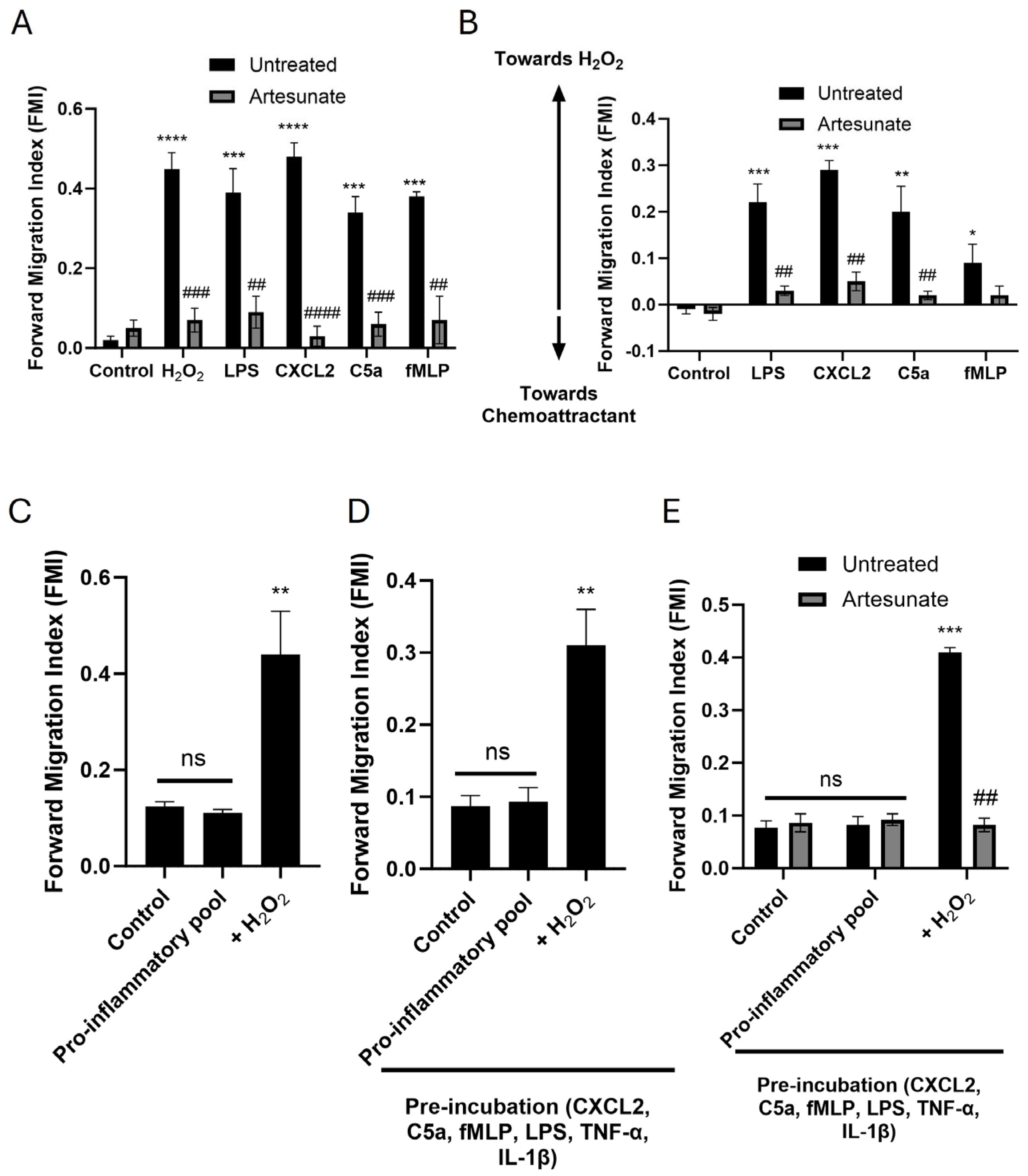
4. Discussion
4.1. Role of H2O2 in Neutrophil Chemotaxis and Paralysis
4.2. Neutrophils Migrate Preferentially Towards H2O2
4.3. Inhibition of Neutrophil Function by the Antimalarial Artesunate
Supplementary Materials
Author Contributions
Funding
Institutional Review Board Statement
Informed Consent Statement
Data Availability Statement
Conflicts of Interest
Abbreviations
| NET | Neutrophil Extracellular Trap |
| H2O2 | Hydrogen Peroxide |
| PPAR-γ | Proliferator-Activated Receptor γ |
| ROS | Reactive Oxygen Species |
| TNF | Tumour Necrosis Factor |
| IL | Interleukin |
| WT | Wild-Type |
| AWERB | Animal Welfare Ethical Review Board |
| ARRIVE | Animal Research: Reporting of In Vivo Experiments |
| fMLP | N-formylmethionine-Leucyl-Phenylalanine |
| LPS | Lipopolysaccharide |
| DMEM | Dulbecco’s Modified Eagle’s Medium |
| FBS | Foetal Bovine Serum |
| PBS | Phosphate-Buffered Saline |
| Cf | Cell-free |
| DNA | Deoxyribonucleic Acid |
| i.p. | Intraperitoneal |
| BALF | Bronchoalveolar Lavage Fluid |
| s.c. | Subcutaneous |
| CO2 | Carbon Dioxide |
| RCF | Relative Centrifugal Force |
| PFS | Perfect Focus System |
| RPM | Revolutions per Minute |
| ELISA | Enzyme-Linked Immunosorbent Assay |
| TLR4 | Toll-like Receptor 4 |
| NF-κB | Nuclear Factor Kappa-Light-Chain-Enhancer of Activated B Cells |
| NADPH | Nicotinamide Adenine Dinucleotide Phosphate |
| NOX | NADPH Oxidase |
| ANOVA | Analysis of Variance |
| SEM | Standard Error of the Mean |
| TRPM2 | Transient Receptor Potential Cation Channel 2 |
| C5a | Complement Component 5a |
| SERCA3 | Sarco/Endoplasmic Reticulum Calcium ATPase 3 |
| GPCR | G protein-Coupled Receptor |
| COVID19 | Coronavirus Disease 2019 |
| NLRP3 | Nucleotide-Binding Domain, Leucine-Rich-Repeat Family Pyrin Domain Containing 3 Protein |
| ATP | Adenosine Triphosphate |
| UPR | Unfolded Protein Response |
| ER | Endoplasmic Reticulum |
| ATF6 | Activating Transcription Factor 6 |
| CXCL | C-X-C motif Chemokine Ligand |
| C5a | Complement Component C5a |
| C557BL/6 | Cold Spring Harbour 57 Black 6 Mouse Strain |
| UK | United Kingdom |
| TL | Thermolysin Low |
| MACS | Magnetic-Activated Cell Sorting |
| NIS | Nikon Imaging Software |
| AR | Advanced Research |
| FIJI | Figi Is Just ImageJ |
| USA | United States of America |
| HRP | Horseradish Peroxidase |
| Caspase | Cysteine-dependent Aspartate-specific Protease |
| FMI | Forward Migration Index |
| P22phox | Cytochrome b-245 Alpha Chain |
References
- De Oliveira, S.; Rosowski, E.E.; Huttenlocher, A. Neutrophil migration in infection and wound repair: Going forward in reverse. Nat. Rev. Immunol. 2016, 16, 378–391. [Google Scholar] [CrossRef]
- Tecchio, C.; Micheletti, A.; Cassatella, M.A. Neutrophil-derived cytokines: Facts beyond expression. Front. Immunol. 2014, 5, 115765. [Google Scholar] [CrossRef]
- Nordenfelt, P.; Tapper, H. Phagosome dynamics during phagocytosis by neutrophils. J. Leukoc. Biol. 2011, 90, 271–284. [Google Scholar] [CrossRef]
- Yousefi, S.; Mihalache, C.; Kozlowski, E.; Schmid, I.; Simonm, H. Viable neutrophils release mitochondrial DNA to form neutrophil extracellular traps. Cell Death Differ. 2009, 16, 1438–1444. [Google Scholar] [CrossRef]
- Gierlikowska, B.; Stachura, A.; Gierlikowski, W.; Demkow, U. Phagocytosis, degranulation and extracellular traps release by neutrophils—The current knowledge, pharmacological modulation and future prospects. Front. Pharmacol. 2021, 12, 666732. [Google Scholar] [CrossRef] [PubMed]
- Leliefeld, P.H.C.; Wessels, C.M.; Leenen, L.P.H.; Koenderman, L.; Pillay, J. The role of neutrophils in immune dysfunction during severe inflammation. Crit. Care 2016, 20, 73. [Google Scholar] [CrossRef]
- Alves-Filho, J.C.; Spiller, F.; Cunha, F.Q. Neutrophil paralysis in sepsis. Shock 2010, 34, 15–21. [Google Scholar] [CrossRef] [PubMed]
- Tharp, W.G.; Yadav, R.; Irimia, D.; Upadhyaya, A.; Samadani, A.; Hurtado, O.; Liu, S.-Y.; Munisamy, S.; Brainard, D.M.; Mahon, M.J.; et al. Neutrophil chemorepulsion in defined interleukin-8 gradients in vitro and in vivo. J. Leukoc. Biol. 2006, 79, 539–554. [Google Scholar] [CrossRef] [PubMed]
- Alves-Filho, J.C.; De Freitas, A.; Russo, M.; Cunha, F.Q. Toll-like receptor 4 signaling leads to neutrophil migration impairment in polymicrobial sepsis. Crit. Care Med. 2006, 34, 461–470. [Google Scholar] [CrossRef]
- Hartung, T.; Sauer, A.; Hermann, C.; Brockhaus, F.; Wendel, A. Overactivation of the immune system by translocated bacteria and bacterial products. Scand. J. Gastroenterol. Suppl. 1997, 32, 98–99. [Google Scholar] [CrossRef]
- Reddy, R.C.; Narala, V.R.; Keshamouni, V.G.; Milam, J.E.; Newstead, M.W.; Standiford, T.J. Sepsis-induced inhibition of neutrophil chemotaxis is mediated by activation of peroxisome proliferator-activated receptor-γ. Blood 2008, 112, 4250–4258. [Google Scholar] [CrossRef]
- Brown, K.; Brain, S.; Pearson, J.; Edgeworth, J.; Lewis, S.; Treacher, D. Neutrophils in development of multiple organ failure in sepsis. Lancet 2006, 368, 157–169. [Google Scholar] [CrossRef]
- Balamayooran, G.; Batra, S.; Fessler, M.B.; Happel, K.I.; Jeyaseelan, S. Mechanisms of neutrophil accumulation in the lungs against bacteria. Am. J. Respir. Cell Mol. Biol. 2010, 43, 5–16. [Google Scholar] [CrossRef] [PubMed]
- Navarini, A.A.; Lang, K.S.; Verschoor, A.; Recher, M.; Zinkernagel, A.S.; Nizet, V.; Odermatt, B.; Hengartner, H.; Zinkernagel, R.M. Innate immune-induced depletion of bone marrow neutrophils aggravates systemic bacterial infections. Proc. Natl. Acad. Sci. USA 2009, 106, 7107–7112. [Google Scholar] [CrossRef] [PubMed]
- Wang, J.-F.; Wang, Y.-P.; Xie, J.; Zhao, Z.-Z.; Gupta, S.; Guo, Y.; Jia, S.-H.; Parodo, J.; Marshall, J.C.; Deng, X.-M. Upregulated PD-L1 delays human neutrophil apoptosis and promotes lung injury in an experimental mouse model of sepsis. Blood 2021, 138, 806–810. [Google Scholar] [CrossRef]
- Park, I.; Kim, M.; Choe, K.; Song, E.; Seo, H.; Hwang, Y.; Ahn, J.; Lee, S.-H.; Lee, J.H.; Jo, Y.H.; et al. Neutrophils disturb pulmonary microcirculation in sepsis-induced acute lung injury. Eur. Respir. J. 2019, 53, 1800786. [Google Scholar] [CrossRef]
- Bajt, M.L.; Farhood, A.; Jaeschke, H. Effects of CXC chemokines on neutrophil activation and sequestration in hepatic vasculature. Am. J. Physiol. Gastrointest. Liver Physiol. 2001, 281, G1188–G1195. [Google Scholar] [CrossRef]
- Doerschuk, C.M. Mechanisms of Leukocyte Sequestration in Inflamed Lungs. Microcirculation 2001, 8, 71–88. [Google Scholar] [CrossRef] [PubMed]
- McDonald, B.; McAvoy, E.F.; Lam, F.; Gill, V.; de la Motte, C.; Savani, R.C.; Kubes, P. Interaction of CD44 and hyaluronan is the dominant mechanism for neutrophil sequestration in inflamed liver sinusoids. J. Exp. Med. 2008, 205, 915–927. [Google Scholar] [CrossRef]
- Czaikoski, P.G.; Mota, J.M.S.C.; Nascimento, D.C.; Sônego, F.; Castanheira, F.V.E.S.; Melo, P.H.; Scortegagna, G.T.; Silva, R.L.; Barroso-Sousa, R.; Souto, F.O.; et al. Neutrophil Extracellular Traps Induce Organ Damage during Experimental and Clinical Sepsis. PLoS ONE 2016, 11, e0148142. [Google Scholar] [CrossRef]
- Liu, S.; Su, X.; Pan, P.; Zhang, L.; Hu, Y.; Tan, H.; Wu, D.; Liu, B.; Li, H.; Li, H.; et al. Neutrophil extracellular traps are indirectly triggered by lipopolysaccharide and contribute to acute lung injury. Sci. Rep. 2016, 6, 37252. [Google Scholar] [CrossRef] [PubMed]
- Jaeschke, H. Reactive oxygen and mechanisms of inflammatory liver injury: Present concepts. J. Gastroenterol. Hepatol. 2011, 26, 173–179. [Google Scholar] [CrossRef]
- Soehnlein, O.; Oehmcke, S.; Rothfuchs, A.G.; Frithiof, R.; van Rooijen, N.; Mörgelin, M.; Herwald, H.; Lindbom, L. Neutrophil degranulation mediates severe lung damage triggered by streptococcal M1 protein. Eur. Respir. J. 2008, 32, 405–412. [Google Scholar] [CrossRef]
- Ginsburg, I.; Korem, M.; Koren, E.; Varani, J. Pro-inflammatory agents released by pathogens, dying host cells, and neutrophils act synergistically to destroy host tissues: A working hypothesis. J. Inflamm. Res. 2019, 12, 35–47. [Google Scholar] [CrossRef]
- Chan, L.; Karimi, N.; Morovati, S.; Alizadeh, K.; Kakish, J.E.; Vanderkamp, S.; Fazel, F.; Napoleoni, C.; Alizadeh, K.; Mehrani, Y.; et al. The Roles of Neutrophils in Cytokine Storms. Viruses 2021, 13, 2318. [Google Scholar] [CrossRef]
- Kasama, T.; Miwa, Y.; Isozaki, T.; Odai, T.; Adachi, M.; Kunkel, S.L. Neutrophil-derived cytokines: Potential therapeutic targets in inflammation. Curr. Drug Targets Inflamm. Allergy 2005, 4, 273–279. [Google Scholar] [CrossRef]
- Tateda, K.; Moore, T.A.; Newstead, M.W.; Tsai, W.C.; Zeng, X.; Deng, J.C.; Chen, G.; Reddy, R.; Yamaguchi, K.; Standiford, T.J. Chemokine-dependent neutrophil recruitment in a murine model of Legionella pneumonia: Potential role of neutrophils as immunoregulatory cells. Infect. Immun. 2001, 69, 2017–2024. [Google Scholar] [CrossRef] [PubMed]
- Pravda, J. Metabolic theory of septic shock. World J. Crit. Care Med. 2014, 3, 45–54. [Google Scholar] [CrossRef] [PubMed]
- Pravda, J. Hydrogen peroxide and disease: Towards a unified system of pathogenesis and therapeutics. Mol. Med. 2020, 26, 41. [Google Scholar] [CrossRef]
- Margotti, W.; Goldim, M.P.d.S.; Machado, R.S.; Bagio, E.; Dacoregio, C.; Bernades, G.; Lanzzarin, E.; Stork, S.; Cidreira, T.; Denicol, T.L.; et al. Oxidative stress in multiple organs after sepsis in elderly rats. Exp. Gerontol. 2022, 160, 111705. [Google Scholar] [CrossRef] [PubMed]
- Morad, H.; Luqman, S.; Tan, C.H.; Swann, V.; McNaughton, P.A. TRPM2 ion channels steer neutrophils towards a source of hydrogen peroxide. Sci. Rep. 2021, 11, 9339. [Google Scholar] [CrossRef]
- Thomas, R.C.; Bath, M.F.; Stover, C.M.; Lambert, D.G.; Thompson, J.P. Exploring LPS-induced sepsis in rats and mice as a model to study potential protective effects of the nociceptin/orphanin FQ system. Peptides 2014, 61, 56–60. [Google Scholar] [CrossRef] [PubMed]
- Jiao, Y.; Tong, C.S.W.; Zhao, L.; Zhang, Y.; Nicholls, J.M.; Rainer, T.H. Intraperitoneal versus intranasal administration of lipopolysaccharide in causing sepsis severity in a murine model: A preliminary comparison. Lab. Anim. Res. 2024, 40, 18. [Google Scholar] [CrossRef] [PubMed]
- Yang, Y.; Liu, Y.; He, X.; Yang, F.; Han, S.; Qin, A.; Wu, G.; Liu, M.; Li, Z.; Wang, J.; et al. ING4 alleviated lipopolysaccharide-induced inflammation by regulating the NF-κB pathway via a direct interaction with SIRT1. Immunol. Cell Biol. 2020, 98, 127–137. [Google Scholar] [CrossRef] [PubMed]
- Morad, H.O.J.; Luqman, S.; Pinto, L.G.; Cunningham, K.P.; Vilar, B.; Clayton, G.; Shankar-Hari, M.; McNaughton, P.A. Artemisinin inhibits neutrophil and macrophage chemotaxis, cytokine production and NET release. Sci. Rep. 2022, 12, 11078. [Google Scholar] [CrossRef]
- Swamydas, M.; Luo, Y.; Dorf, M.E.; Lionakis, M.S. Isolation of Mouse Neutrophils. Curr. Protoc. Immunol. 2015, 110, 3.20.1–3.20.15. [Google Scholar] [CrossRef]
- Pinto, L.G.; Talbot, J.; Peres, R.S.; Franca, R.F.; Ferreira, S.H.; Ryffel, B.; Aves-Filho, J.C.F.; Figueiredo, F.; Cunha, T.M.; Cunha, F.Q. Joint production of IL-22 participates in the initial phase of antigen-induced arthritis through IL-1β production. Arthritis Res. Ther. 2015, 17, 235. [Google Scholar] [CrossRef]
- Appell, C.R.; Jiwan, N.C.; Wang, R.; Shen, C.L.; Luk, H.Y. Ginger Supplementation Attenuated Mitochondrial Fusion and Improved Skeletal Muscle Size in Type 2 Diabetic Rats. In Vivo 2024, 38, 73–81. [Google Scholar] [CrossRef]
- Kashyap, N.; Islam, M.; Kaur, H.; Tiwari, D.; Begum, A.; Bose, M.; Das, C.R.; Saikia, A.K.; Kalita, P.; Bose, P.D.; et al. Oxidative stress—A key determinant of complications and negative outcome in hepatitis E virus infected pregnancies: A comprehensive account involving cases from northeast India. J. Med. Virol. 2023, 95, e28576. [Google Scholar] [CrossRef]
- Guo, Q.; Jin, Y.; Chen, X.; Ye, X.; Shen, X.; Lin, M.; Zeng, C.; Zhou, T.; Zhang, J. NF-κB in biology and targeted therapy: New insights and translational implications. Signal Transduct. Target. Ther. 2024, 9, 53. [Google Scholar] [CrossRef]
- Chen, Y.; Hu, H.; Tan, S.; Dong, Q.; Fan, X.; Wang, Y.; Zhang, H.; He, J. The role of neutrophil extracellular traps in cancer progression, metastasis and therapy. Exp. Hematol. Oncol. 2022, 11, 99. [Google Scholar] [CrossRef] [PubMed]
- Smith, A.P.; Creagh, E.M. Caspase-4 and -5 Biology in the Pathogenesis of Inflammatory Bowel Disease. Front. Pharmacol. 2022, 13, 919567. [Google Scholar] [CrossRef] [PubMed]
- Downs, K.P.; Nguyen, H.; Dorfleutner, A.; Stehlik, C. An overview of the non-canonical inflammasome. Mol. Aspects Med. 2020, 76, 100924. [Google Scholar] [CrossRef]
- Lambeth, J.D. NOX enzymes and the biology of reactive oxygen. Nat. Rev. Immunol. 2004, 4, 181–189. [Google Scholar] [CrossRef]
- Surabhi, S.; Jachmann, L.H.; Shumba, P.; Burchhardt, G.; Hammerschmidt, S.; Siemens, N. Hydrogen Peroxide Is Crucial for NLRP3 Inflammasome-Mediated IL-1β Production and Cell Death in Pneumococcal Infections of Bronchial Epithelial Cells. J. Innate Immun. 2021, 14, 192. [Google Scholar] [CrossRef]
- Benjamim, C.F.; Silva, J.S.; Fortes, Z.B.; Oliveira, M.A.; Ferreira, S.H.; Cunha, F.Q. Inhibition of leukocyte rolling by nitric oxide during sepsis leads to reduced migration of active microbicidal neutrophils. Infect. Immun. 2002, 70, 3602–3610. [Google Scholar] [CrossRef]
- Arraes, S.M.A.; Freitas, M.S.; da Silva, S.V.; Neto, H.A.d.P.; Alves-Filho, J.C.; Martins, M.A.; Basile-Filho, A.; Tavares-Murta, B.M.; Barja-Fidalgo, C.; Cunha, F.Q. Impaired neutrophil chemotaxis in sepsis associates with GRK expression and inhibition of actin assembly and tyrosine phosphorylation. Blood 2006, 108, 2906–2913. [Google Scholar] [CrossRef]
- Yoo, S.K.; Starnes, T.W.; Deng, Q.; Huttenlocher, A. Lyn is a redox sensor that mediates leukocyte wound attraction in vivo. Nature 2011, 480, 109–112. [Google Scholar] [CrossRef]
- Niethammer, P.; Grabher, C.; Look, A.T.; Mitchison, T.J. A tissue-scale gradient of hydrogen peroxide mediates rapid wound detection in zebrafish. Nature 2009, 459, 996–999. [Google Scholar] [CrossRef]
- Klyubin, I.V.; Kirpichnikova, K.M.; Gamaley, I.A. Hydrogen peroxide-induced chemotaxis of mouse peritoneal neutrophils. Eur. J. Cell Biol. 1996, 70, 347–351. [Google Scholar] [PubMed]
- Yamamoto, S.; Shimizu, S.; Kiyonaka, S.; Takahashi, N.; Wajima, T.; Hara, Y.; Negoro, T.; Hiroi, T.; Kiuchi, Y.; Okada, T.; et al. TRPM2-mediated Ca2+ influx induces chemokine production in monocytes that aggravates inflammatory neutrophil infiltration. Nat. Med. 2008, 14, 738–747. [Google Scholar] [CrossRef]
- Lipcsey, M.; Bergquist, M.; Sirén, R.; Larsson, A.; Huss, F.; Pravda, J.; Furebring, M.; Sjölin, J.; Janols, H. Urine Hydrogen Peroxide Levels and Their Relation to Outcome in Patients with Sepsis, Septic Shock, and Major Burn Injury. Biomedicines 2022, 10, 848. [Google Scholar] [CrossRef]
- Nethery, D.; Callahan, L.A.; Stofan, D.; Mattera, R.; DiMarco, A.; Supinski, G. PLA2 dependence of diaphragm mitochondrial formation of reactive oxygen species. J. Appl. Physiol. 2000, 89, 72–80. [Google Scholar] [CrossRef]
- Fink, M.P. Reactive oxygen species as mediators of organ dysfunction caused by sepsis, acute respiratory distress syndrome, or hemorrhagic shock: Potential benefits of resuscitation with Ringer’s ethyl pyruvate solution. Curr. Opin. Clin. Nutr. Metab. Care 2002, 5, 167–174. [Google Scholar] [CrossRef] [PubMed]
- Fukumoto, K.; Pierro, A.; Spitz, L.; Eaton, S. Cardiac and renal mitochondria respond differently to hydrogen peroxide in suckling rats. J. Surg. Res. 2003, 113, 146–150. [Google Scholar] [CrossRef] [PubMed]
- Willmann, K.; Moita, L.F. Physiologic disruption and metabolic reprogramming in infection and sepsis. Cell Metab. 2024, 36, 927–946. [Google Scholar] [CrossRef] [PubMed]
- Petry, A.; Zhang, Z.; Trautz, B.; Rieß, F.; Görlach, A. Cross Talk Between p22phox and ATF4 in the Endothelial Unfolded Protein Response. Antioxid. Redox Signal 2019, 30, 40–55. [Google Scholar] [CrossRef]
- Lu, H.L.; Huang, X.Y.; Luo, Y.F.; Tan, W.P.; Chen, P.F.; Guo, Y.B. Activation of M1 macrophages plays a critical role in the initiation of acute lung injury. Biosci. Rep. 2018, 38, 20171555. [Google Scholar] [CrossRef]
- Cao, Q.; Harris, D.C.H.; Wang, Y. Macrophages in kidney injury, inflammation, and fibrosis. Physiology 2015, 30, 183–194. [Google Scholar] [CrossRef]
- Aggarwal, N.R.; King, L.S.; D’Alessio, F.R. Diverse macrophage populations mediate acute lung inflammation and resolution. Am. J. Physiol. Lung Cell. Mol. Physiol. 2014, 306, 709–725. [Google Scholar] [CrossRef]
- Hess, K.M.; Goad, J.A.; Arguin, P.M. Intravenous artesunate for the treatment of severe malaria. Ann. Pharmacother. 2010, 44, 1250–1258. [Google Scholar] [CrossRef] [PubMed]
- Roussel, C.; Ndour, P.A.; Kendjo, E.; Larréché, S.; Taieb, A.; Henry, B.; Lebrun-Vignes, B.; Chambrion, C.; Argy, N.; Houzé, S.; et al. Intravenous Artesunate for the Treatment of Severe Imported Malaria: Implementation, Efficacy, and Safety in 1391 Patients. Clin. Infect. Dis. 2021, 73, 1795–1804. [Google Scholar] [CrossRef]
- Stenlo, M.; Silva, I.A.N.; Hyllén, S.; Bölükbas, D.A.; Niroomand, A.; Grins, E.; Ederoth, P.; Hallgren, O.; Pierre, L.; Wagner, D.E.; et al. Monitoring lung injury with particle flow rate in LPS- and COVID-19-induced ARDS. Physiol. Rep. 2021, 9, e14802. [Google Scholar] [CrossRef]
- Olwal, C.O.; Nganyewo, N.N.; Tapela, K.; Djomkam, L.A.; Owoicho, O.; Bediako, Y.; Duodu, S. Parallels in Sepsis and COVID-19 Conditions: Implications for Managing Severe COVID-19. Front. Immunol. 2021, 12, 602848. [Google Scholar] [CrossRef]
- Gainetdinov, R.R.; Kurochkin, S.V. Lung lesions caused by COVID-19 in comparison with bacterial pneumonia and influenza pneumonia: Pathomorphological features. Kazan Med. J. 2021, 102, 703–715. [Google Scholar] [CrossRef]
- Liu, Y.; Dang, W.; Zhang, S.; Wang, L.; Zhang, X. Artesunate attenuates inflammatory injury and inhibits the NF-κB pathway in a mouse model of cerebral ischemia. J. Int. Med. Res. 2021, 49, 03000605211053549. [Google Scholar] [CrossRef]
- Ho, W.E.; Cheng, C.; Peh, H.Y.; Xu, F.; Tannenbaum, S.R.; Ong, C.N.; Wong, W.F. Anti-malarial drug artesunate ameliorates oxidative lung damage in experimental allergic asthma. Free Radic. Biol. Med. 2012, 53, 498–507. [Google Scholar] [CrossRef]
- Golatkar, V.; Bhatt, L.K. Artesunate attenuates isoprenaline induced cardiac hypertrophy in rats via SIRT1 inhibiting NF-κB activation. Eur. J. Pharmacol. 2024, 977, 176709. [Google Scholar] [CrossRef]
- Silva, C.M.S.; Wanderley, C.W.S.; Veras, F.P.; Sonego, F.; Nascimento, D.C.; Gonçalves, A.V.; Martins, T.V.; Cólon, D.F.; Borges, V.F.; Brauer, V.S.; et al. Gasdermin D inhibition prevents multiple organ dysfunction during sepsis by blocking NET formation. Blood 2021, 138, 2702–2713. [Google Scholar] [CrossRef] [PubMed]
- Alsabani, M.; Abrams, S.T.; Cheng, Z.; Morton, B.; Lane, S.; Alosaimi, S.; Yu, W.; Wang, G.; Toh, C.-H. Reduction of NETosis by targeting CXCR1/2 reduces thrombosis, lung injury, and mortality in experimental human and murine sepsis. Br. J. Anaesth. 2021, 128, 283–293. [Google Scholar] [CrossRef] [PubMed]
- Cao, T.-H.; Jin, S.-G.; Fei, D.-S.; Kang, K.; Jiang, L.; Lian, Z.-Y.; Pan, S.-H.; Zhao, M.-R.; Zhao, M.-Y. Artesunate Protects Against Sepsis-Induced Lung Injury Via Heme Oxygenase-1 Modulation. Inflammation 2016, 39, 651–662. [Google Scholar] [CrossRef] [PubMed]
- Li, B.; Li, J.; Pan, X.; Ding, G.; Cao, H.; Jiang, W.; Zheng, J.; Zhou, H. Artesunate protects sepsis model mice challenged with Staphylococcus aureus by decreasing TNF-α release via inhibition TLR2 and Nod2 mRNA expressions and transcription factor NF-κB activation. Int. Immunopharmacol. 2010, 10, 344–350. [Google Scholar] [CrossRef] [PubMed]
- Zhang, E.; Wang, J.; Chen, Q.; Wang, Z.; Li, D.; Jiang, N.; Ju, X. Artesunate ameliorates sepsis-induced acute lung injury by activating the mTOR/AKT/PI3K axis. Gene 2020, 759, 144969. [Google Scholar] [CrossRef] [PubMed]
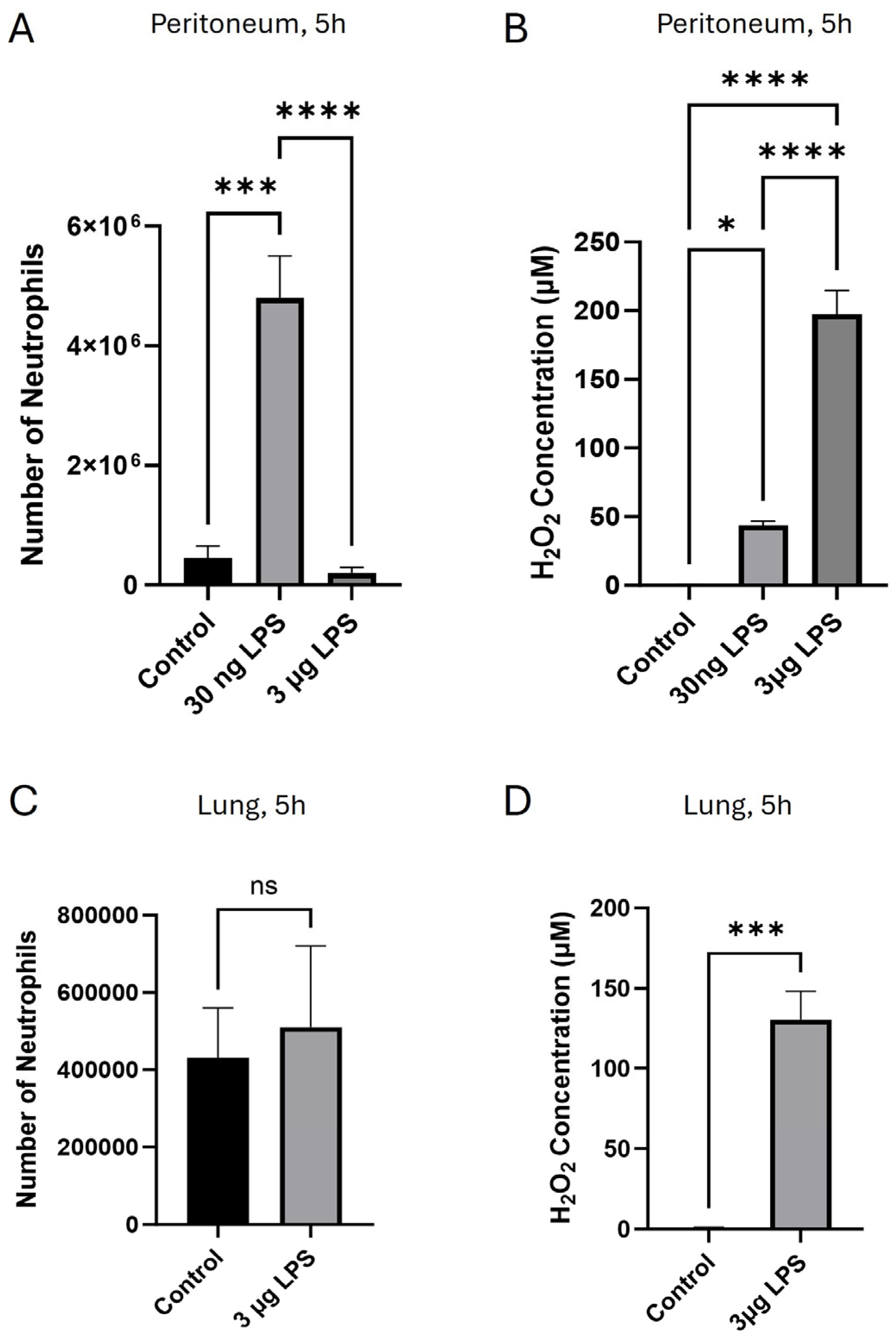
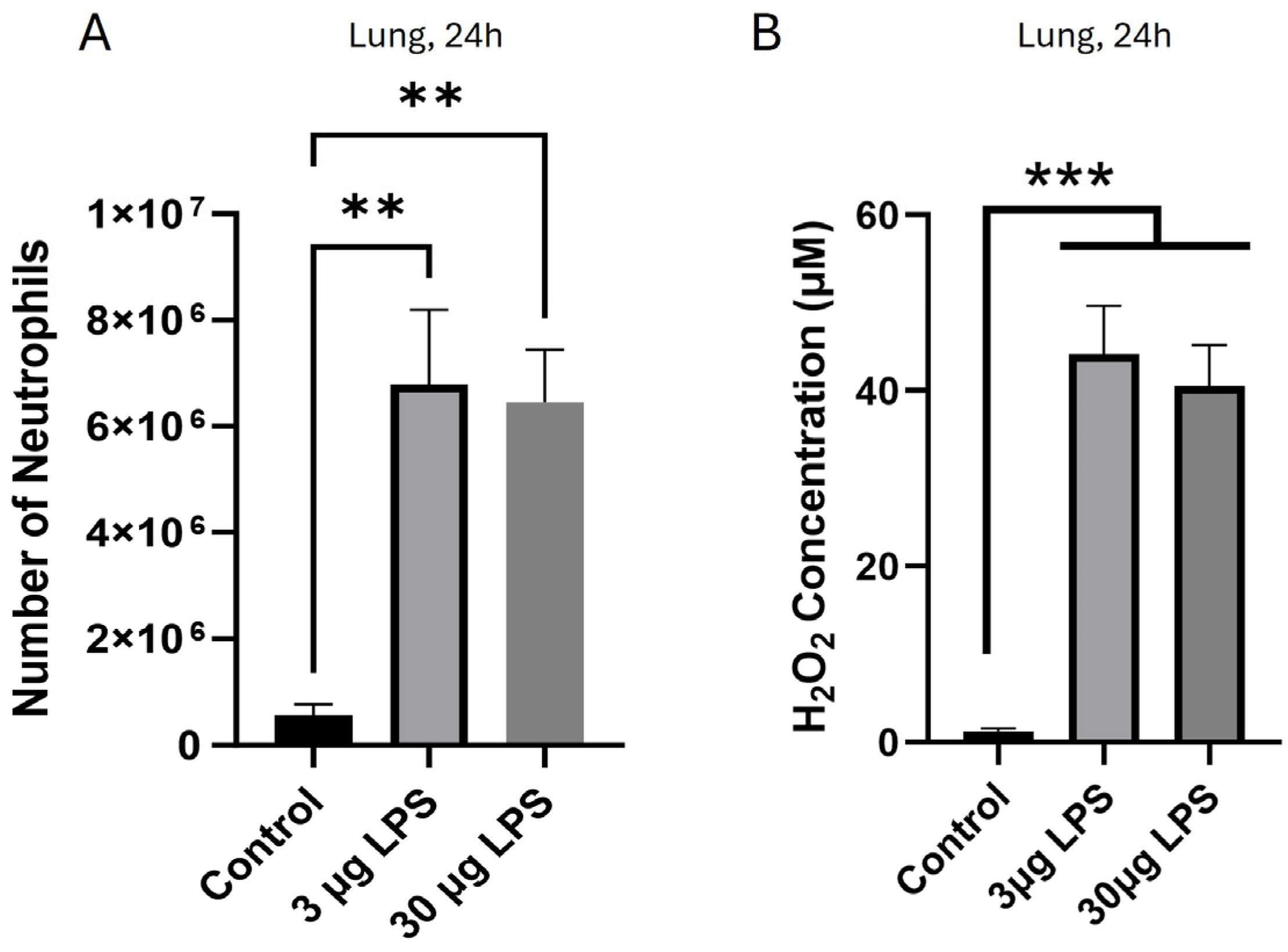
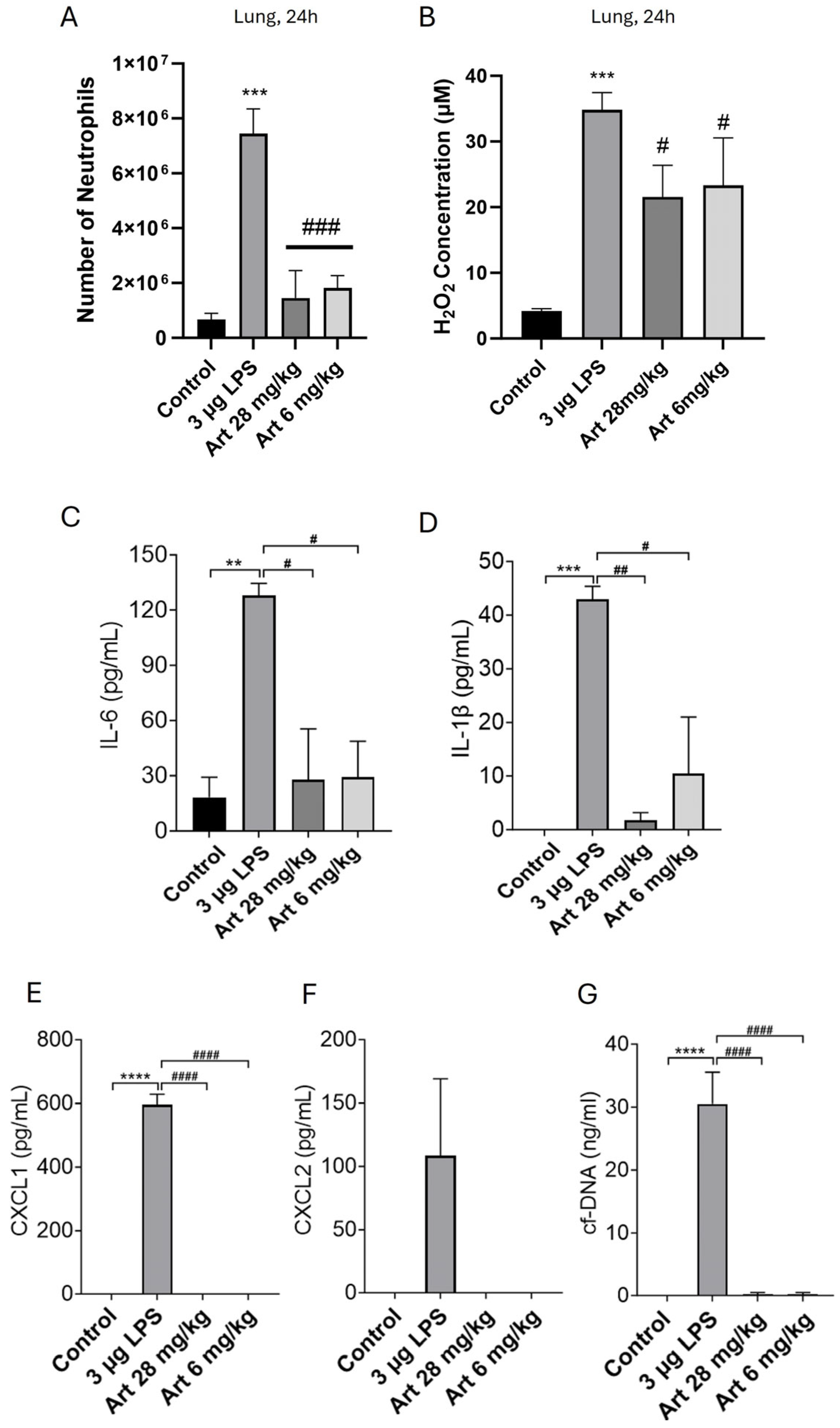
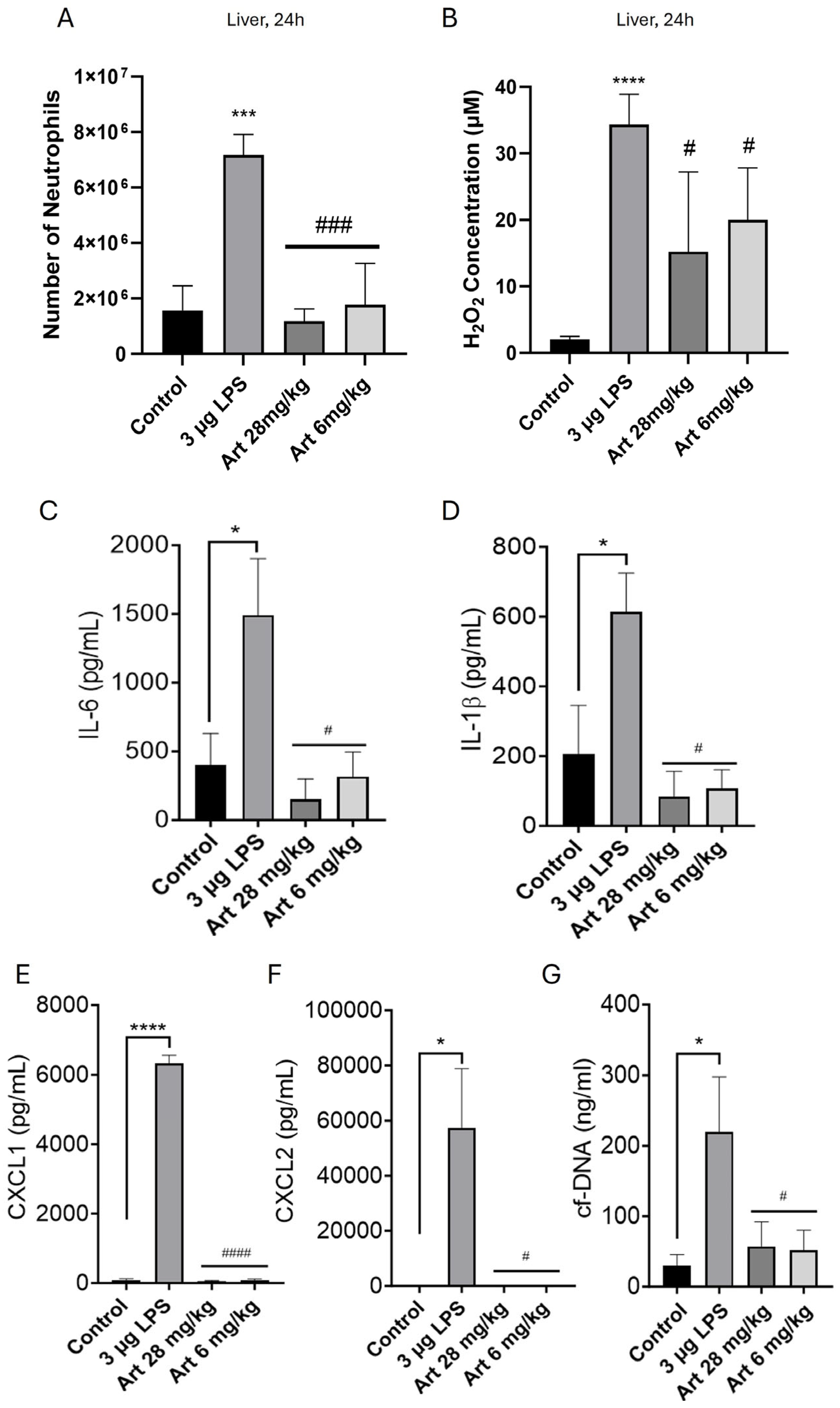
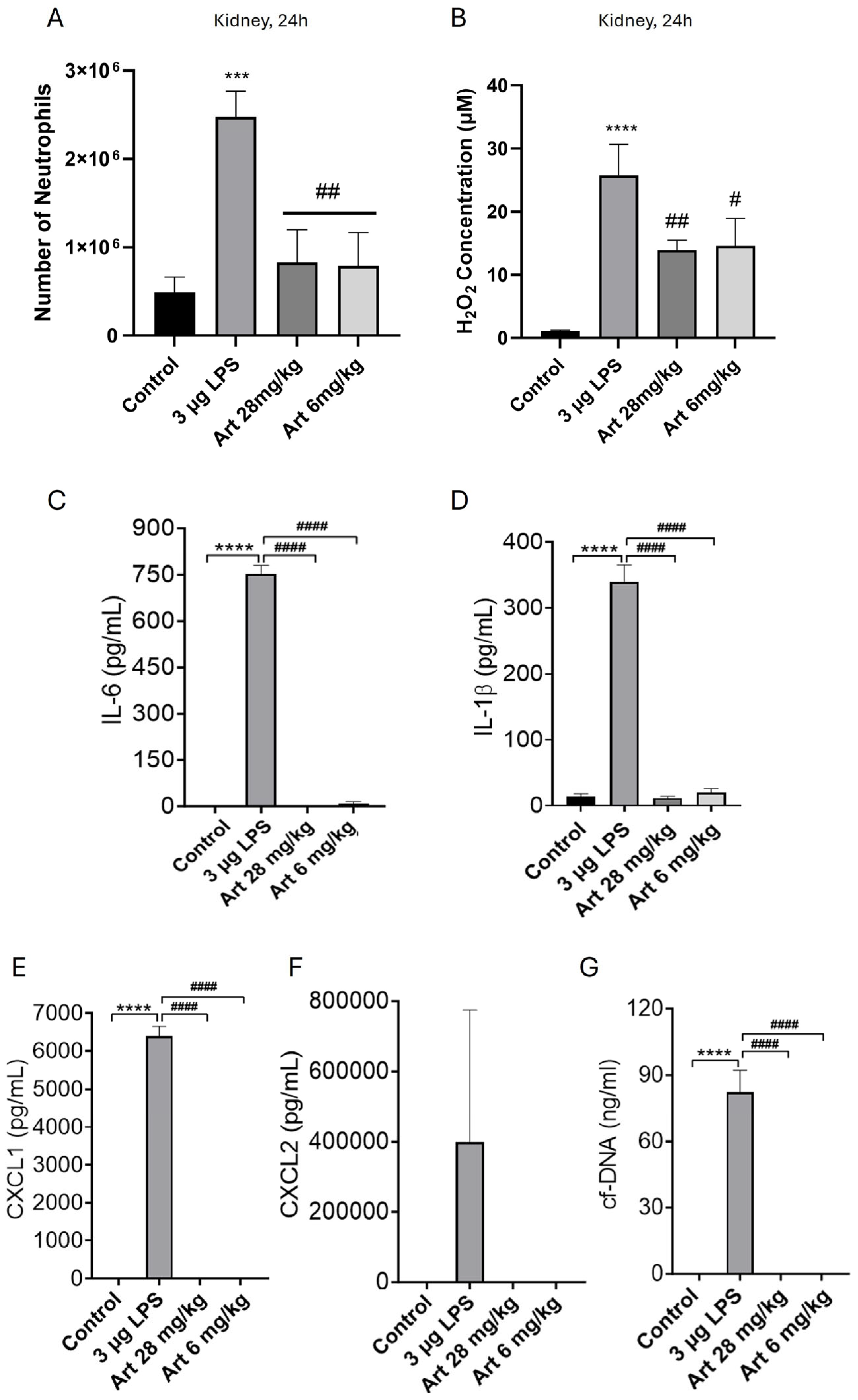
Disclaimer/Publisher’s Note: The statements, opinions and data contained in all publications are solely those of the individual author(s) and contributor(s) and not of MDPI and/or the editor(s). MDPI and/or the editor(s) disclaim responsibility for any injury to people or property resulting from any ideas, methods, instructions or products referred to in the content. |
© 2025 by the authors. Licensee MDPI, Basel, Switzerland. This article is an open access article distributed under the terms and conditions of the Creative Commons Attribution (CC BY) license (https://creativecommons.org/licenses/by/4.0/).
Share and Cite
Morad, H.O.J.; Garcia-Pinto, L.; Clayton, G.; Davoodbeglou, F.; Monzon, A.; McNaughton, P.A. Hydrogen Peroxide and Neutrophil Chemotaxis in a Mouse Model of Bacterial Infection. Immuno 2025, 5, 47. https://doi.org/10.3390/immuno5040047
Morad HOJ, Garcia-Pinto L, Clayton G, Davoodbeglou F, Monzon A, McNaughton PA. Hydrogen Peroxide and Neutrophil Chemotaxis in a Mouse Model of Bacterial Infection. Immuno. 2025; 5(4):47. https://doi.org/10.3390/immuno5040047
Chicago/Turabian StyleMorad, Hassan O. J., Larissa Garcia-Pinto, Georgia Clayton, Foad Davoodbeglou, Arturo Monzon, and Peter A. McNaughton. 2025. "Hydrogen Peroxide and Neutrophil Chemotaxis in a Mouse Model of Bacterial Infection" Immuno 5, no. 4: 47. https://doi.org/10.3390/immuno5040047
APA StyleMorad, H. O. J., Garcia-Pinto, L., Clayton, G., Davoodbeglou, F., Monzon, A., & McNaughton, P. A. (2025). Hydrogen Peroxide and Neutrophil Chemotaxis in a Mouse Model of Bacterial Infection. Immuno, 5(4), 47. https://doi.org/10.3390/immuno5040047





